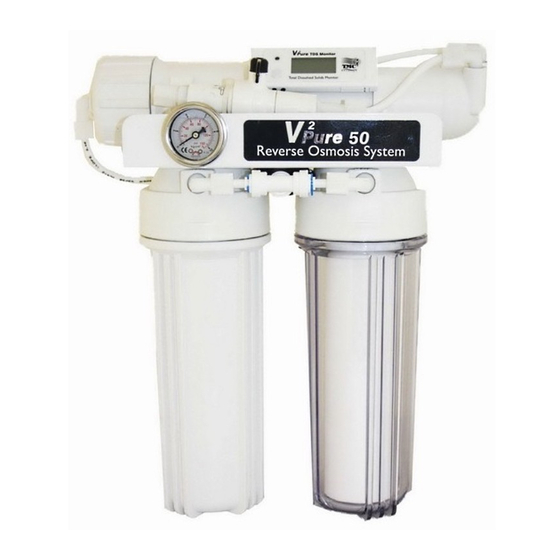Advertisement
Advertisement
Table of Contents

Summary of Contents for TMC V2 Pure
- Page 1 Pure Reverse Osmosis System ™...
- Page 2 V2 Pure 50 - suitable for producing up to 50 US gal/425 UK gal/188 litres per day* V2Pure 75 – suitable for producing up to 75 US gal/63 UK gal/285 litres per day* V2Pure 100 – suitable for producing up to 100 US gal/84 UK gal/380 litres per day* * NB: RO water production capacities and contaminant rejection rates are based on an ambient temperature of 25°C and a...
- Page 3 Pure Reverse Osmosis System INSTRUCTIONS FOR INST LL TION ND USE Important Safety Information - Please Read Carefully - Installation of this V Pure RO System and the connection of the system to the mains water supply is a relatively simple process. However we strongly recommend that, if you do not have experience of such installations, this work is carried out by a qualified plumber.
-
Page 4: Parts List
P RTS LIST - V Pure Reject Water 20 18 1. Wall mounting bracket. Pure Water 2. Feed water (mains water) inlet (to order replacement 90° hosetail including hosetail locking nut order code 5873). 3. 10” 5 micron sediment filter housing (transparent housing) (order code 5870). - Page 5 P RTS LIST - V Pure dvanced 1. Wall mounting bracket. Reject Water 2. Feed water (mains water) inlet (to order replacement 90° hosetail including hosetail locking nut order code 5873). 3. 10” 5 micron sediment filter housing (transparent housing) (order code 5870).
-
Page 6: Installation Parts
P RTS REQUIRED FOR INST LL TION (NOT SUPPLIED) dditional connection fittings (depending on individual installation requirements). If connecting to a garden or washing machine tap a threaded tap connector must be purchased. dditional ¼” RO flexible tubing (depending on individual installation requirements). 3. -
Page 7: Installation
INST LL TION 1. Position the V Pure RO System in a location where it can be easily mounted and secured (ideally to a vertical surface such as a wall) and where it can be easily connected to a cold water mains supply. - Page 8 11. Carefully unscrew the hosetail locking nut on the feedwater (mains water) inlet 90° hosetail (2) and thread the end of the RO flexible tubing (WHITE feed water tubing) (23) through the hole in the end of the locking nut, and insert this end into the feedwater (mains water) inlet 90°...
-
Page 9: Operation
USEFUL TIP: The V Pure RO System is supplied with a drain saddle clamp (27) which can be installed on a suitable section of 1 ” (40mm) waste pipe (i.e a section that is not flooded with water and drains away easily for example a section of waste pipe beneath a kitchen sink) and used to make a permanent connection for the RO reject water tubing. -
Page 10: Maintenance
M INTEN NCE 1. Regularly check to ensure that the RO system is operating correctly, all connections are tight and secure and there are no leaks in the installation. 2. To prolong the life expectancy of the RO membrane, the RO membrane should be regularly flushed to clear any residue that may have settled inside the membrane. -
Page 11: Troubleshooting
USEFUL TIP: n increase in the pressure reading on the pressure gauge indicates that the flow restrictor (18) is blocked and needs cleaning or flushing through (see 2 in ‘maintenance’ above). USEFUL TIP: V Pure TDS (Total Dissolved Solids) Monitor (sold separately) can be simply installed in-line on the RO system to measure and provide a highly accurate ‘real-time’... - Page 12 Problem: Pure water flow rate is too low. 1. Possible Cause: If the reject water flow rate is also too low, the 5 micron sediment filter, active carbon block filter and RO membrane could be dirty. Solution: Check the 5 micron sediment filter and active carbon block filter and replace accordingly.



Need help?
Do you have a question about the V2 Pure and is the answer not in the manual?
Questions and answers